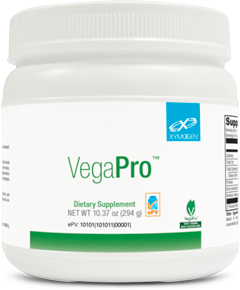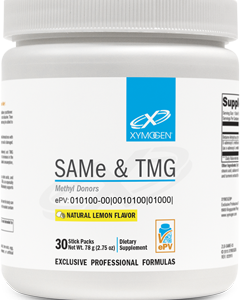Scientific Information/Data
Adequate, good-quality protein helps the body sustain proper functioning. For instance, the amino acid supply (from dietaryprotein) is used to build functional proteins needed for healthy immune function and to produce the enzymes and hormones needed for metabolism, digestion, and other important processes like detoxification and bone remodeling.[1-4] XYMOGEN developed VegaPro to offer practitioners and patients a “clean,” unadulterated vegetable protein that enables a high level of protocol personalization.
“Clean” Protein VegaPro is an excellent choice of supplementary protein for vegans and those who are sensitive to sugar (including lactose), sweeteners, or flavorings.[5-7] It is also free of gluten. VegaPro provides protein from pea and rice sources, avoiding major food allergens including milk, egg, soy, and wheat. The pea protein in VegaPro is non-GMO and is naturally obtained by simple water extraction, keeping all the nutritional qualities intact.*
Flexible Formulation Aside from providing clean, easily digestible vegetable protein, the advantage of VegaPro is its flexibility. While other protein supplements provide high levels of various micronutrients, making it difficult to add protein to a patient’s nutritional protocol, VegaPro is not enriched with extra micronutrients. Therefore, practitioners can design personalized protocols for their patients by directing them to add selected supplements to a VegaPro shake or take encapsulated or tableted micronutrient supplements along with VegaPro. Additionally, VegaPro can easily be added to any functional food formula—if added protein is desired—without the concern of getting too much of any micronutrient. Because this formula is free of sugars and flavorings, it can be added to any approved beverage; or it can be mixed with pure water for a mild, earthy, pea soup taste.*
Excellent Quality Proteins for dietetic foods must provide good basic nutritional quality, which, in this case, means a high protein level, a well-balanced amino acid profile, and good digestibility. At 98% digestibility, pea protein is considered highly digestible and matches that of beef, milk, and soy protein digestibility. The protein content of the pea protein features a well-balanced amino acid profile (listed on reverse side), including a high content of lysine, arginine, and branched-chain amino acids (leucine, isoleucine, and valine). Amino acid scoring provides a way to predict how efficiently protein will meet a person’s amino acid needs. Because pea protein alone is incomplete, combining it with rice protein makes VegaPro a complete protein with an amino acid score of 100%.*
Satisfaction: An Added Benefit of Increasing Protein Intake Signals that originate from the gut, in response to mechanical (gastric distention) and chemical changes that occur after the ingestion of food, let us know when we’ve had enough to eat. Among the macronutrients, proteins have been identified as having the greatest impact in this regard. Actually, the effect of high-protein foods is not only observed immediately after their consumption by a stronger feeling of satisfaction but also at a later meal by supporting a lower food intake.*[8]
Added Amino Acids L-Glutamine is an energy substrate for most cells—especially intestinal epithelial cells and immune cells. It is also an essential component for numerous metabolic functions.[9,10] Glycine, an inhibitory (calming) neurotransmitter, is an important constituent of collagen and a building block for other substances such as coenzyme A, nucleic acids, creatine phosphate, purines, bile, and other amino acids. Taurine is a derivative of sulfur-containing cysteine with many healthful clinical applications, including the support of stable cell membranes, cardiovascular health, glucose tolerance, detoxification, and bile salt synthesis.*[11]
*These statements have not been evaluated by the Food and Drug Administration. This product is not intended to diagnose, treat, cure, or prevent any disease.
References
1. Kerstetter JE, O’Brien KO, Insogna KL. Low protein intake: the impact oncalcium and bone homeostasis in humans. J Nutr. 2003 Mar;133(3):855S-61S.[PMID: 12612169]
2. Protein intake and metabolism in frail elderly – Geriatric Nutrition. BNET – The CBS Interactive Business Network Web site. http://findarticles.com/p/articles/ mi_m0887/is_10_22/ai_110727292/. Published October, 2003 (in Nutrition Research Newsletter). Accessed July 22, 2011.
3. Chernoff R. Protein and older adults. J Am Coll Nutr. 2004 Dec;23(6 Suppl):627S-30S. [PMID: 15640517]
4. Evans WJ. Protein nutrition, exercise and aging. J Am Coll Nutr. 2004 Dec;23(6 Suppl):601S-09S. [PMID: 15640513]
5. Rigamonti E, Parolini C, Marchesi M, et al. Hypolipidemic effect of dietary pea proteins: Impact on genes regulating hepatic lipid metabolism. Mol Nutr Food Res. 2010 May;54 Suppl 1:S24-30. [PMID: 20077421]
6. Jürgens H, Haass W, Castañeda TR, et al. Consuming fructose-sweetened beverages increases body adiposity in mice. Obes Res. 2005 Jul;13(7):1146- 56. [PMID: 16076983]
7. Stanhope KL, Schwarz JM, Keim NL, et al. Consuming fructose-sweetened, not glucose-sweetened, beverages increases visceral adiposity and lipids and decreases insulin sensitivity in overweight/obese humans. J Clin Invest. 2009 May;119(5):1322-34. doi:10.1172/JCI37385. [PMID: 19381015]
8. Johnstone AM, Stubbs RJ, Harbron CG. Effect of overfeeding macronutrients on day-to-day food intake in man. Eur J Clin Nutr. 1996 Jul;50(7):418-30. [PMID: 8862477]
9. Oliveira GP, Dias CM, Pelosi P, et al. Understanding the mechanisms of glutamine action in critically ill patients. An Acad Bras Cienc. 2010 Jun;82(2):417-30. [PMID: 20563423]
10. Walsh NP, Blannin AK, Robson PJ, et al. Glutamine, exercise and immune function. Links and possible mechanisms. Sports Med. 1998 Sep;26(3):177-91. [PMID: 9802174]
11. Yatabe Y, Miyakawa S, Ohmori H, et al. Effects of taurine administration on exercise. Adv Exp Med Biol. 2009;643:245-52. [PMID: 19239155]







Reviews
There are no reviews yet.